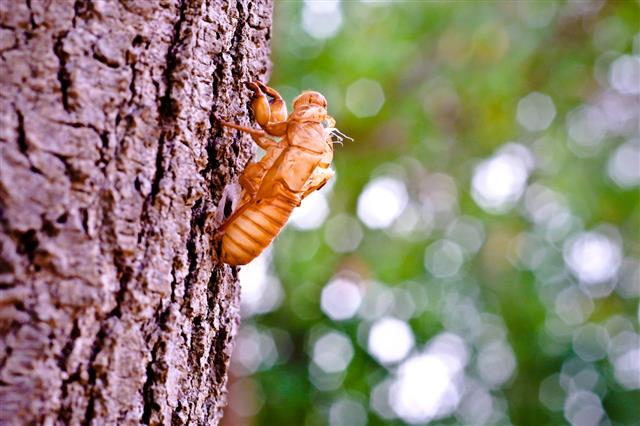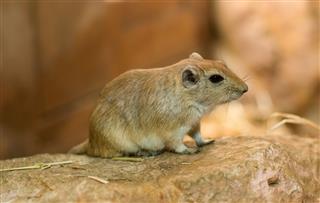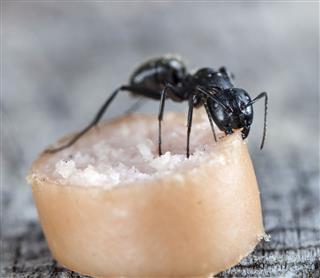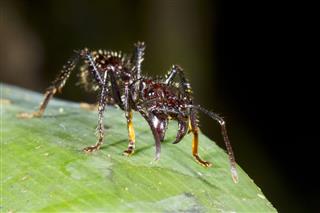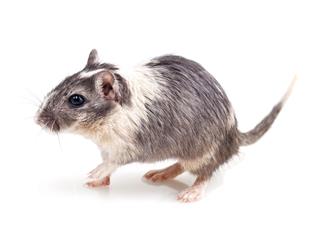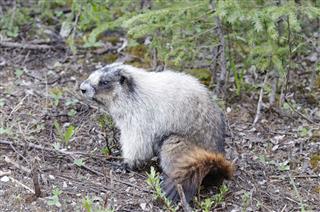
Burrowing animals, as their name suggests, excavate tunnels into the ground to create space to live and reproduce. AnimalSake provides a picture gallery of some burrowing animals. Take a look!
Bugs Bunny
Bugs Bunny, a popular Warner Bros. cartoon is a young, clever rabbit who lives in a fully-furnished burrow.
There’s almost no class in the animal kingdom that doesn’t include burrowing animals. The burrowing lifestyle is popular among different classes of animals which include mammals, amphibians, reptiles, birds, insects, and rodents. An even broader classification would divide the animals into two major categories―vertebrates and invertebrates.
When it comes to digging, animals are adept at exploring different terrains; all of these animals burrow in the ground, or in the sand, under concrete, under loamy soil, in gardens, farms or backyards, and the like. Burrows can range from a simple hole to a complex network of underground tunnels and chambers spanning hundreds and thousands of meters in length.
Scroll below to see and read about a variety of burrowing animals that belong to classes mentioned above.
European Rabbit
European rabbits (Oryctolagus cuniculus) belong to southwestern Europe and are infamous for their destructive behavior. They eat shrubs in orchards and forests causing heavy loss of vegetation and biodiversity. Rabbits are also domesticated widely across the world, either for food or as pets.
Quick Fact: In 1907, an attempt (not successful) to construct a rabbit-proof fence was made in Australia to bar the westward expansion of the species.
Red Fox
Red foxes dig their burrows in areas like mountain slopes, ditches, depressions, steep water banks, etc. They prefer a well-drained spot to dig a burrow. A red fox’s burrow is made up of a main den and temporary dugouts.
Quick Fact: Although they’re called red foxes, they occur in colors more than red which include, gray, blackish-brown, silver, platinum, amber, and even white.
Groundhog
Groundhogs tend to build their dens in farms, fruit orchards, and corn fields; technically places which consist of small flowering trees or bushes. A den has four to five holes connected to a main tunnel, which leads further to a 3-4 ft. deep den.
Quick Fact: Groundhogs are known to practice proper hygiene by building separate holes to defecate.
Common Otter
River otters, being semi-aquatic, prefer their dens to be close to water. They choose dens constructed by other animals or dig in natural hollows to live in.
Quick Fact: River otters are killed mostly for their thick and lustrous fur, which is used to make jackets and coats.
Badger
Badgers are nocturnal mammals who dig complex networks of underground tunnels connecting to their respective dens. They have a long black and white snout, and sharp claws required to dig. Their preferred habitats are sandy, loamy soils which ideally have easy access to freshwater and prey.
Quick Fact: A white stripe extends from the badger’s nose covering the complete length of his body, spanning up to the tip of the tail.
Fennec Fox
Unlike red foxes, a fennec fox digs its burrow under sheltered and stable sand dunes. They are native to the Sahara of North Africa, which is somewhat evident from their habitat and are a comparatively small species of foxes. They are known to show a typical neighborly behavior by adjoining their dens with those of other foxes, and thus coexist in harmony.
Quick Fact: Fennec foxes are domesticated as exotic pets in some parts of the world and are quite expensive as they are removed as kits from their mother and hand-reared.
Mole
Moles are small mammals with a pointed conical snout, velvety fur, and unnoticeable eyes and ears. Their forelimbs have large paws with pointed fingers which help them dig efficiently. They feed on earthworms and other small, soil-dwelling invertebrates. A mole is known to heap soil and create a hill surrounding the entrance of the den.
Quick Fact: Moles have a unique ability to reuse inhaled oxygen, hence allowing them to survive in low-oxygen environment.
Mongoose
The mongoose is, technically, a collective name for 38 different species. Mongooses build and also use already existing burrows for their habitat needs.
Quick Fact: In the Indian subcontinent, mongooses are tamed by snake charmers for mock fights with snakes to impress the audience.
Shrew
The common shrew is native to Britain and exists commonly in scrubland, grassland, hedgerows, and woodland. Shrews mostly occupy burrows dug by other animals and surface every 2-3 hours to feed themselves. Shrews feed on insects, spiders, worms, amphibians, and small rodents.
Quick Fact: Shrews are known to shrink in winter, due to which they require less effort to move, and ultimately, need lesser food to survive. Shrews are comparatively less active in winter.
Sand Dollar
Although they look like shells, they are living organisms. Sand dollars’ undersides have spines covered with cilia that assist in locomotion and digging through sand. It ingests food using tiny podia, which move food to the mouth opening. Sand dollars feed on algae, detritus, crustacean larvae, diatoms, and small copepods.
Quick Fact: Sand dollars bury themselves partially under the sand with an edge poking up as shown in the image.
Ant
Ants are some of the most common burrowing creatures. Although ants dig holes, they create huge mounds of soil right at the entrance while excavating. Ants feed on everything from sugar, fruits, meats, seeds, vegetables, and fungi.
Quick Fact: Omnivorous ants also have cannibalistic tendencies, and do not hesitate to eat other ants.
Meerkat
Meerkats belong to the mongoose family, and possess the unique ability to stand upright. They are native to southwestern Africa and exist in clans. All clans have interconnected dens, which they vacate during daytime and scavenge for food. The dens have several entrances, which are easily accessible in case of oncoming danger.
Quick Fact: A clan of meerkats consist of 20 to 50 individual meerkats.
Cicada
Cicadas are small flying insects that belong to the Hemiptera order. They reside in small burrows, preferably near trees that provide food and a place to lay eggs. They have strong front limbs that help them dig; their burrows have a depth ranging from 1 ft. to 8.2 ft. Cicadas feed on xylem sap from the roots of oak, cypress, willow, ash, and maple.
Quick Fact: Cicadas are consumed either skewered, deep-fried, or stir-fried in the north Chinese cuisine.
Pika
Although a majority of pikas choose crevices and rocky mountain sides to live, there are some burrowing species of pikas called daurian pikas. They are found all across Mongolia, Russia, Manchuria, and various provinces of China. They burrow in mountainous regions at high altitudes (4,000 mt.), and are often spotted in desert grasslands during winters.
Quick Fact: A very striking feature about pikas is that they do not have a tail.
Chipmunk
Chipmunks are native to North America and belong to the Rodentia order. They are known to dig extensive burrows which they use to rest, store food, and defecate. They are very neat when it comes to personal hygiene and use different chambers or tunnels to defecate. A chipmunk’s burrow can be as deep as 11 ft.
Quick Fact: Chipmunks often set out to collect food at the onset of autumn and remain in their burrows throughout winter until spring.
Gerbil
The gerbil is a small, rat-like rodent native to Africa and Asia, which lives in sandy and arid regions. They dig complex network of burrows with several entrances which are easily accessible. They are diurnal and omnivorous.
Quick Fact: As gerbils can destroy vegetation and harm indigenous ecosystem, it is illegal to keep or trade gerbils as pets in the U.S. state of California.
Jerboa
Jerboas, in some aspects, look like miniature kangaroos. They are native to arid regions of north Africa, Asia, and China, and are recognized for their distinctive hopping abilities. Jerboas construct temporary as well as permanent burrows, the temporary ones help them take cover while hunting during day/night; the permanent ones are for shelter and reproduction.
Quick Fact: When threatened or chased, jerboas can run at speeds peaking to 24 km/hr.
Tarantula Spider
Tarantulas are large hairy spiders, and are found in various parts of the world which include, America (central, northern, and western parts), Africa, Asia, Australia, and Europe. Tarantulas dig deep single-holed burrows that are lined with silk; the lining provides stability, facilitates entering and exiting, and also alerts them of a potential threat.
Quick Fact: Although tarantulas are venomous, their bite is not fatal and would only cause prolonged discomfort and irritation. The venom of the African tarantula is known to cause hallucinations.
Ferret
Ferrets make very good house pets, especially due to their adorable playfulness. In their natural habitats, they prefer excavating multi-channeled burrows to rest and reproduce. Being carnivorous, ferrets feed on small mammals, which mostly include mice and rabbit. They can very efficiently chase these animals out of their burrows and hunt them.
Quick Fact: Ferrets, when excited, perform something called a ‘weasel war dance’. They hop and leap sideways, often bumping into nearby objects.
Slow Worm
Although slow worms look like tiny snakes, they belong to the lizard family. As their name suggests, they are slow moving and are game to birds, badgers, foxes, and hedgehogs. Slow worms mostly burrow in warm areas like grasslands and woodlands. These worms feed on caterpillars, spiders, and earthworms.
Quick Fact: Slow worms are one of the few reptile species which are viviparous (giving birth to live young ones).
Earthworm
Being very common worms, earthworms dwell in loamy soil. They contract and expand their bodies for the purpose of locomotion, which also helps them burrow into the soil. They feed on living or dead organic matter, and are also responsible for soil fertility.
Quick Fact: Earthworms do not have any specific organs for respiration. They respire using their moist skin.
Desert Tortoise
Desert tortoises use burrows to rest and also as a means of escaping extreme temperatures. They prefer areas with sandy, loamy soil with proportionate amounts of clay and gravel, such that digging is easier and dens are stable enough to avoid collapse. Desert tortoises are known to share burrows with other reptiles, mammals, birds, and invertebrates.
Quick Fact: Desert tortoises are listed under the vulnerable category due to their rapidly declining population. The most relevant threats to these tortoises include urbanization, habitat destruction, illegal collection, and vandalism by humans.
Hamster
Hamsters are cheeky little rodents which feed on seeds, fruit, vegetation, and burrowing insects. Their elongated cheek pouches help them to carry food to their burrows. Their burrows are smartly constructed with separate chambers for nesting, food storage, and defecation; burrows will typically have several entrances. Hamsters are very popular as pets, especially Syrian hamsters.
Quick Fact: Hamsters are short-sighted and color-blind.
Burrowing Owl
Burrowing owls are found throughout north and south America in areas like grasslands, farms, woodlands, and deserts. These owls, in most cases, occupy already constructed burrows by small mammals like hedgehogs or prairie dogs. They collect a variety of materials to line their burrows, one of which includes animal dung.
Quick Fact: Burrowing owls, unlike other owls, are diurnal and collect food during the day.
Aardvark
Don’t confuse this nocturnal mammal as an anteater. Aardvarks are mostly found in sub-Saharan Africa, and mostly choose muddy or sandy terrain, which is easier for them to dig. They dig deep underground burrows for resting during the day, and also to avoid warm weather. Aardvarks feed on ants and termites.
Quick Fact: An aardvark’s burrow can be as long as 43 ft. and are large enough for a human to easily enter it.
Mexican Burrowing Toad
Burrowing toads have slimy, bloated bodies; they are marked with red spots, and a red stripe extends along the back. These toads have small, pointed snouts and short legs. Their feet are hard and rough with wide shovel-shaped extensions, which assist them to dig efficiently. Although these toads live underground, they emerge from their holes during the breeding season and lay eggs in a nearby water source.
Quick Fact: According to ‘Evolutionarily Distinct and Globally Endangered’ (EDGE), the Mexican Burrowing toad is the most evolutionary and distinct amphibian on Earth.
Likewise, burrowing animals are further classified into various other species as well as subspecies. We have only covered the tip of the iceberg.






